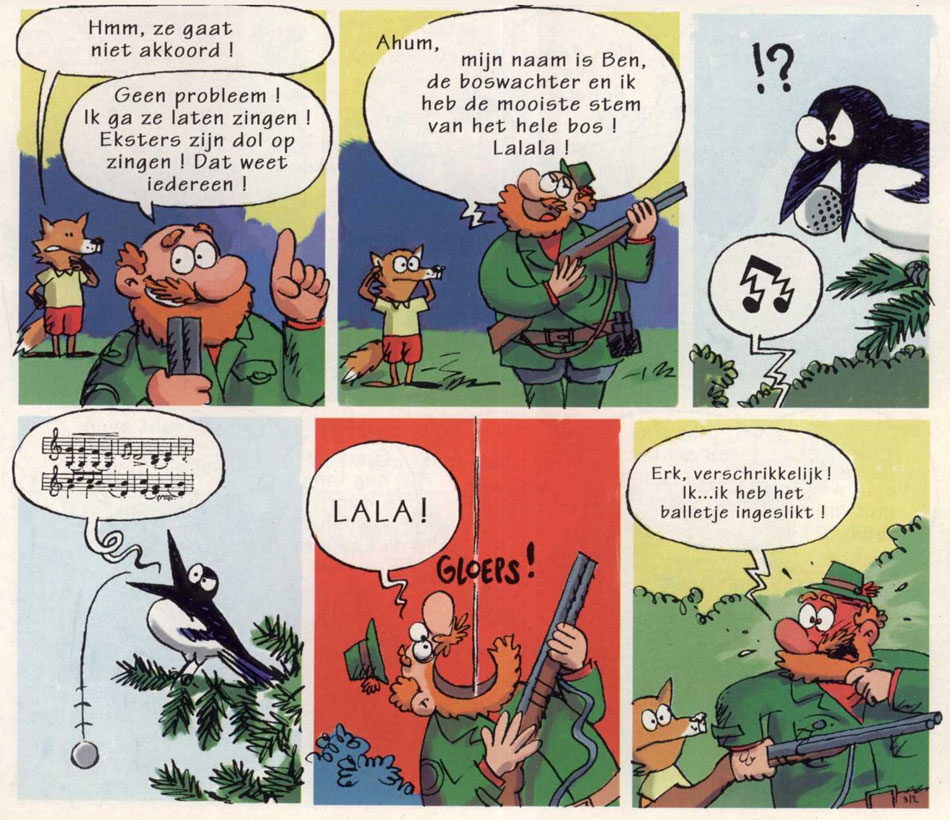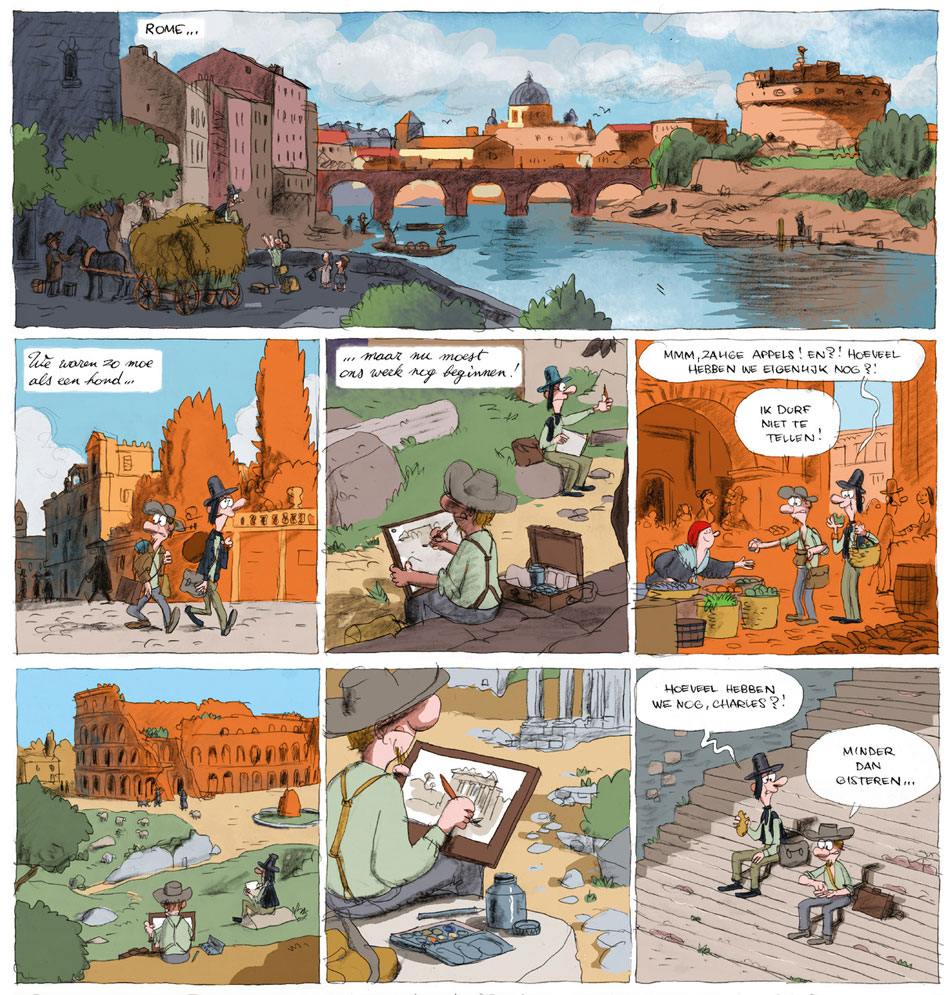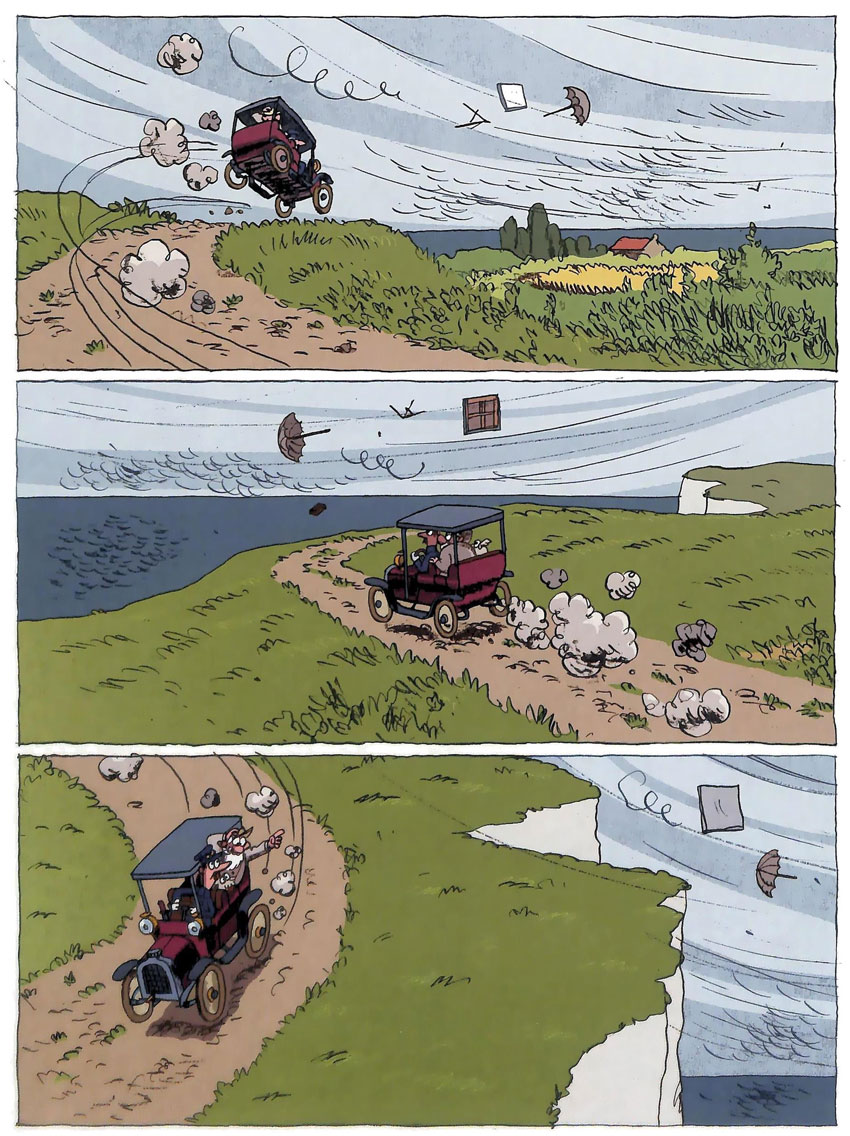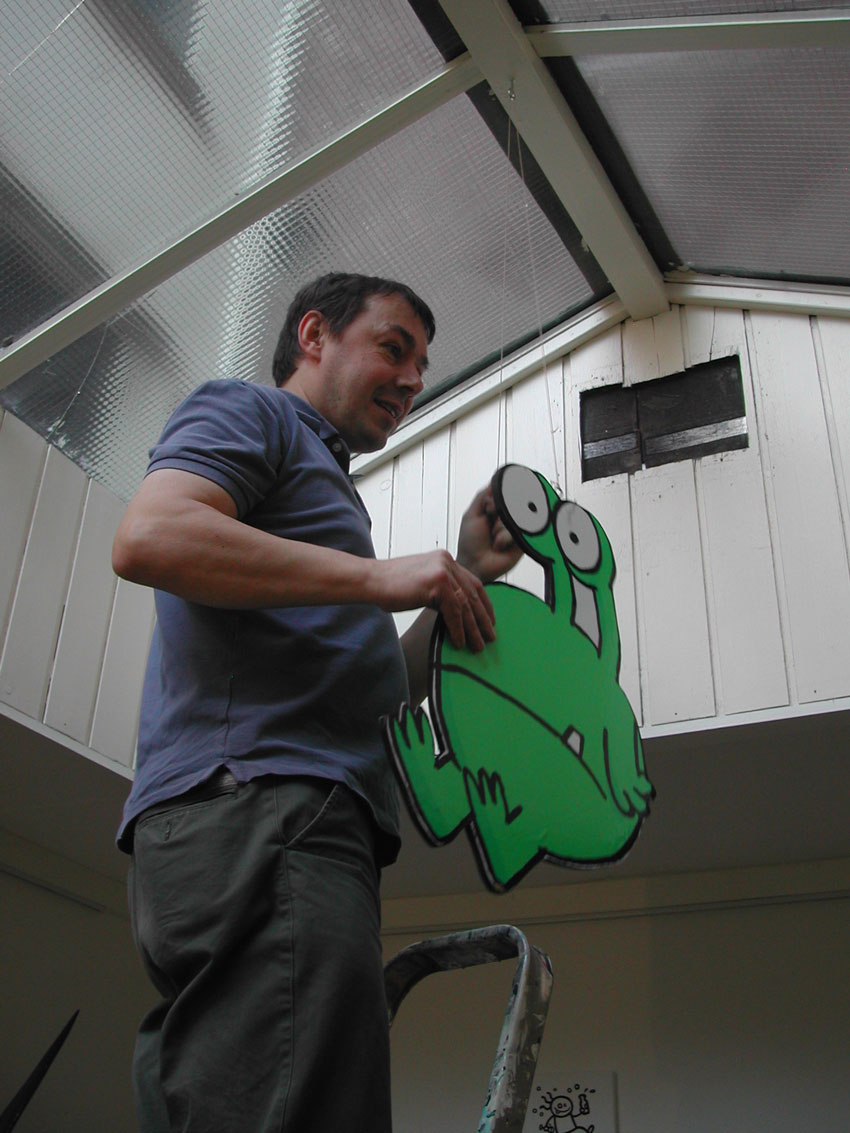Luc Cromheecke is a Flemish comic artist, best-known for several absurd humorous comics, of which the pantomime comic 'Plunk' (2006-2013), about a pink extraterrestrial, is the most internationally recognizable. Cromheecke gained a cult following with the surreal gag comics 'Tom Carbon' (1985-1996) and 'Taco Zip' (1985-1992, 1999-2006). In collaboration with scriptwriter Willy Linthout, he also drew the charming children's comic 'Roboboy' (2002-2009). Cromheecke's style can be described as a cute, child-friendly mix between the Dupuis school and Flemish absurdism in the tradition of Marc Sleen. A frequent contributor to Spirou magazine since 1985, he is one of the few Flemish artists who gained popularity in the French-language press. His work has additionally been published in Spanish, Indonesian, Danish and German. Later in life, he turned to creating graphic novels about famous painters. Together with Bruno De Roover, he created the biographical graphic novel 'De Tuinen van Daubigny' (2016) about 19th-century French painter Charles-François Daubigny, and 'De Magnifieke Monet' (2023- ), a graphic novel series about painter Claude Monet.
Early life and influences
Luc Cromheecke was born in 1961 in Antwerp. Coming from an artistic family, his grandfather was a sculptor of religious statues and his great-uncle was the Antwerp animal sculptor Josuë Dupon. Cromheecke grew up reading Flemish comics like Willy Vandersteen's 'Suske en Wiske' and Marc Sleen's 'Nero', and also Franco-Belgian classics like André Franquin's 'Gaston Lagaffe', Hergé's 'Tintin', 'Astérix' by Albert Uderzo and René Goscinny and 'Lucky Luke' by Morris and Goscinny. Other graphic influences are Dutch artists Windig & De Jong, the British caricaturist H.M. Bateman, the Frenchman Lewis Trondheim and the Americans Cliff Sterrett, George Herriman, Saul Steinberg, Peter Arno, Eldon Dedini, Sergio Aragonès and Robert Crumb.
In the early 1980s, Cromheecke studied painting, graphics and advertising at the Royal Academy of Fine Arts in Antwerp. However, he couldn't resist doodling funny characters on his etchings. After many disagreements with his graphic arts teacher, Cromheecke dropped out of school. It wasn't a huge deal to him, since his comics were already appearing in various magazines by the time he was 18. At the Academy, he however became friends with fellow students Laurent Letzer and Gert Wijninckx (AKA Fritzgerald), who became his regular collaborators.
Luc Cromheecke is married to comic colorist Sabine De Meyer, who has worked for Studio Vandersteen and also colors Cromheecke's comics.
First published comic page in Robbedoes: 'Bob Burk' (issue # 2177, 3 January 1980).
Early comics
Cromheecke was only 18 years old when his first comics were published in the magazines Blondie and Robbedoes. In the pop-cultural magazine Blondie, he made the comic strip 'Zap', about a motorcyclist who resembles rock musician Frank Zappa, of whom Cromheecke is a fan. In Robbedoes (the Dutch-language version of Spirou), he drew a handful of gags of the filler humor comic 'Bob Burk' (1980), about a private investigator. He signed them with the pseudonym "Maf" (Dutch for "mad" or "looney"). At the time, Flemish or Dutch artists were given the opportunity to create a gag page for the magazine whenever the French-language parent edition had an extra advertisement or an untranslatable editorial page. Besides Cromheecke, magazine editor Ruud Straatman and an artist known as Jittoku also appeared on these pages.
Other early work by Cromheecke appeared in De Gazet van Antwerpen (the comic 'Wendy en de Ufonauten'), Knack, Top, TV-Express, Stic, Carrick, Kartoen and some action group papers. Cromheecke preferred making silly comics with his pals Laurent Letzer and Fritzgerald for their own alternative magazine Flan Imperial, of which only one issue appeared in 1987. Flan Imperial also featured comics by Pévé, Philippe Bercovici, Hugo van Look and the Dutch artist duo Windig & De Jong.
Tom Carbon
In 1985, Cromheecke and Laurent Letzer created the character 'Tom Carbon' ('Tom Carbone', in French). In the early stories, Mr. Carbon is an odd uncle who tells his nephew weird and witty fables and stories in hilarious short stories, for instance how croissants come from the moon and how Easter Bunnies on Easter Island produce easter eggs by request of the Vatican, and also about a vegetarian wolf, bears with circus ambitions and penguin slaves. Quite exceptionally, his shenanigans ran in both the Dutch-language Robbedoes and its French-language edition Spirou. While French-language comics in Spirou easily received a Dutch translation in Robbedoes, few Dutch-language comics caught on in Spirou. 'Tom Carbon' debuted in issue #2461 (11 June 1985) and remained popular with readers. The series developed into a hilarious humorous gag and adventure comic, with Tom himself in the starring role, of which the longer stories 'Luna Toys' (1988) and 'Tannenbaum' (2004) are the most notable. However, the latter story remained unfinished for many years, because the Spirou editors preferred Letzer and Cromheecke's one-page gag comics. Notable recurring characters in the absurd stories are the strongman Jakkepoep and Tom's vegetarian neighbor, Wortelmans. In 1996, the series was canceled in Spirou, although some sporadic new gags have appeared during the 2000s. Between 1991 and 1993, the series also ran in The Netherlands in Sjors en Sjimmie Stripblad.
Between 1991 and 1994, Éditions Dupuis collected the series in four albums. Between 2010 and 2012, 'Tom Carbon' was picked up by the Dutch publishing house Strip2000. The first albums were reprinted with new covers, and 'Lunatoys' and 'Tannenbaum' got their long awaited book publications. In 2012, Glénat also published a French-language compendium. In addition, 'Tom Carbon' has appeared in translation in German (as 'Fritz Lakritz'), Danish and Indonesian.
'Taco Zip'. Translation: "Let's read my horoscope for today: 'Watch out today! Especially for people in your direct vicinity." - "Well, well, Vantilt, reading your little paper during office hours?!".
Taco Zip
For the mail section of the weekly Robbedoes, Cromheecke and his friend Fritzgerald created the eccentric gag strip 'Taco Zip' (1985-1992, 1999-2006). The series stars a pig-faced police officer, Vantilt, and his bossy superior Kapitein Piep, who is a mouse. Other side characters are even wackier, such as Harold the pig, Wilbur the duck and Plunk the extraterrestrial. Frizgerald and Cromheecke came up with surreal plotlines, among others featuring a talking tree and a fridge which turns out to be a time portal to the Middle Ages. Remarkably enough, the comic's title hero, a tall bearlike character, hardly appeared in his own strip, and was even phased out completely by 1986!
Initially, both Cromheecke and Fritzgerald worked on both the gags and the artwork, but eventually they divided these tasks with Fritzgerald writing and Cromheecke drawing. The duo modelled 'Taco Zip' after U.S. newspaper comics like Charles M. Schulz's 'Peanuts' and Johnny Hart's 'B.C.', but the absurd silliness owed its debt to Pévé's 'La Plus Mauvaise BD du Monde' ("The Worst Comic in the World") and Windig & De Jong's 'Heinz'.
In early 1988, 'Taco Zip' disappeared from the pages of Robbedoes, but was remarkably enough picked up by the magazine's French edition Spirou instead. From issue #2622 (13 July 1988) to #2734 (5 September 1990), reworked and colorized versions of earlier 'Taco Zip' strips ran as 'Les Tacozip' on Spirou's colophon page. In The Netherlands, the strip was acquired by the newspaper De Volkskrant, where it debuted on 2 January 1989. By switching from a weekly to a daily production rhythm, the authors came up with more running gags, such as the ever-uncooperative weather, Monday mornings, Wilbur crashing his car, Vantilt writing tickets, Agent Plunk and Detective Vantilt, the Plunkmobile, the environment, and Vantilt's questionable work ethic. To keep up with the workload, Jakketoe (a pseudonym for firefighter and saxophonist Jan Peeters) was brought in as an additional writer. After about a thousand episodes, the final 'Taco Zip' strip appeared in De Volkskrant on 30 December 1992.
'Taco Zip and Plunk!' Translation: "Hey, Plunk, I didn't know you played guitar!" - "Me neither, but since I have been making sounds with this thing it's difficult to deny!"
In 1991, 'Taco Zip' also appeared in the Flemish newspaper De Morgen. Between 1993 and 1998, the series was on hiatus, but from April 1999 to 2000 it returned in the Metro supplement of De Morgen, and from 2003 to 2006 in the comic supplements of the newspapers Belang van Limburg and Gazet van Antwerpen. Between 2000 and 2005, these new daily strips also appeared in French in Spirou. Book collections of 'Taco Zip' have been released by the Dutch publishers Oog & Blik and BeeDee.
With its offbeat humor and minimalistic artwork, 'Taco Zip' often polarized readers, both in Robbedoes and in De Volkskrant. Some enjoyed its silly comedy and non-sequiturs, while others despised its simplicity. Not surprisingly, 'Taco Zip' became a cult favorite among students. The character Plunk inspired the names for a student society in Delft and a guitar band from Eindhoven, and two former students from Radboud University named their academic publishing imprint Vantilt.
'Ben de Boswachter', from Suske en Wiske Weekblad #20, 1997.
Ben, Le Forestier / Ben de Boswachter
After the cancellation of 'Tom Carbon' and during the 'Taco Zip' pause, Luc Cromheecke and his friends began working on new projects. For the French magazine Astrapi (Bayard Presse), Cromheecke and Letzer created 'Ben, Le Forestier' ("Ben The Woodman", 1996), about a bearded woodman who often notices strange things in the woods and who is able to talk with animals. Astrapi also featured the character in a few CD-roms. Still, his presence in the magazine was limited: Ben only lasted two short stories. Between 1997 and 1998, the series enjoyed a modest but more successful run in the Flemish weekly comic magazine Suske en Wiske Weekblad, where it appeared under the title 'Ben De Boswachter'. The commercial TV channel VTM once considered adapting 'Ben Le Forestier' into a series of animated shorts, but the project was eventually scrapped.
Roboboy
In 2002, Cromheecke began a collaboration with fellow comic artist Willy Linthout (of 'Urbanus' fame). With Linthout as writer and Cromheecke as artist, they created the funny children's comic 'Roboboy' (2002-2009), not to be confused with Jan van Rijsselberge's animated TV character 'Robotboy' (2005-2008). Roboboy is a little extraterrestrial robot from the planet of Kryptobot. After a nuclear explosion, he fell to Earth, where he is adopted by Mr. and Mrs. Kwabbelmans, a childless couple who also own a dog named Kastaar. Roboboy has trouble adapting to his new environment and vice versa. People find him strange, because he is not a "real" boy. He drinks oil and has numerous unusual gadgets hidden inside his armor. Some people dislike him, while others just misunderstand his good intentions. Yet he often manages to surprise them and subvert their prejudices. The charmingly innocent stories surprised some adults who previously associated Linthout with the depravity of the 'Urbanus' comic. Many children's magazines ran 'Roboboy', among them Taptoe, Spirou and - under the different title 'Supersnotneus' - Suske en Wiske Weekblad too. Between 2003 and 2009, book collections were published by Dupuis and Catullus.
At the 2003 Prix Saint-Michel Festival in Brussels, the authors received the award for "Best Dutch-language author" and "Best Dutch-language children's author". 'Roboboy' also won "Best Dutch-language Children's Album" during the 2003 Stripdagen in Alphen aan den Rijn.
Plunk
One of life's recurring ironies is that sometimes the work creators put the least thought or effort in, unpredictably becomes their biggest hit. Such was the case with Luc Cromheecke and Laurent Letzer's 'Plunk'. When in 1989 the Belgian Comic Strip Center opened its doors in Brussels, the authors were asked to create a story about how comics are commercialized. Cromheecke drew a bizarre pink creature whose nose looks like a car horn. He wears a green funnel on his head and has shorts in the same color. In the sample comic, an aspiring artist dreams how Plunk, as the character was named, becomes a global success. He strikes a deal with a publisher, album sales rise and the character is aggressively merchandized, turning the artist into a millionaire. Yet in the final panels, the cartoonist brutally wakes up from his daydream. The crowd who cheered "Plunk! Plunk!" was just the sound of water dripping from the ceiling of his paltry apartment.
The 'Plunk' comic was on permanent display in the Belgian Comic Strip Center for years. Letzer and Cromheecke just came up with the most stupid and ridiculous choice for a comic character and considered him nothing more than a throwaway idea, a parody of successful franchises like Peyo's 'Smurfs'. Ironically, Plunk not only became a "real" comic character later, but effectively Letzer and Cromheecke's biggest global success. It all started in 1990, when Plunk became a regular character in Cromheecke and Fritzgerald's 'Taco Zip' comic, establishing him as an extraterrestrial. After 'Taco Zip' ended halfway the decade, the artist didn't use Plunk again for a full decade. Just like Cromheecke's 'Ben Le Forestier', Plunk was considered for a series of animated shorts broadcast on the commercial TV network VTM, but the project went nowhere.
In 2006, Plunk received his own gag comic, 'Plunk!', which ran in Spirou, the Dutch magazines Myx and Eppo, as well as in the Arabic magazine Majid and even in Norway and a Chinese youth magazine. Its pantomime comedy allowed for easy translation. Three albums were released, as well as a Chinese-language edition presenting all three stories in one package. In 2008, a comic award named after the character was established in Belgium, De Plastieken Plunk ("The Plastic Plunk"). On 2 October 2012, Plunk received his own statue in the Oude Heidestraat in Kapellen, Belgium, designed by Joris Peeters. He also received a wooden statue, designed by Pol Trekker, on display in the Arboretum in Kalmthout. The town also has a comic mural starring Plunk.
Later work for Spirou
Cromheecke and his partners Letzer and Fritzgerald remained associated with Spirou and Robbedoes until 1997, when their contract was terminated due to low sales in France. After working for other magazines for a while, Cromheecke returned to Spirou in 1999. Since then, the magazine has run new and older episodes of his comics 'Taco Zip', 'Tom Carbon' and 'Roboboy', but also new comics and editorial cartoons by Luc Cromheecke. Since 1999, together with Jean-Michel Thiriet, he has made a weekly promotional cartoon to attract new subscribers. In 2005, he notably made the cover illustration for the final edition of Spirou's Dutch-language edition, Robbedoes.
L'Île Carrément Perdue / Het Godvrrgeten Eiland
Between 2011 and 2014, Cromheecke began a new comic with the French scriptwriter and cartoonist Sti, an admirer of 'Tom Carbon'. Their joint effort, 'L'Île Carrément Perdue' ("The Goddamned Lost Island") appeared in Spirou, and also in the Dutch magazine Eppo as 'Het Godvrrgeten Eiland'. The series follows a castaway and his dog who are stranded on a deserted island. In typical Cromheecke fashion, they meet a bunch of funny side characters, such as local natives, pirates and various exotic animals. Dupuis also collected the series in two albums. After their first series, Cromheecke and Sti continued their collaboration with the short-lived 'Spirounizer X-700' (2015-2016), a science fiction editorial feature.
'De Tuin van Daubigny' (2016).
Painter biographies
In his spare time, Cromheecke has been active as a landscape painter. One of his favorite inspirations is the obscure 19th-century French impressionistic landscape painter Charles-François Daubigny (1817-1878). Daubigny worked in a sketchy - not to say cartoony - style, devoid of any pretense. The painter loved making landscapes from the comfort of his little boat. Despite not being a household name, Daubigny had a strong influence on the French impressionist movement and the Dutch painter Vincent van Gogh. As it happened, Cromheecke learned that the comic writer Bruno De Roover shared his enthusiasm for Daubigny. To expand his fame among modern audiences, they decided to make a biographical graphic novel about the artist, a project that took three years in the making. Made in collaboration with the Van Gogh Museum in Amsterdam and with funding from the Flemish Literary Fund, the end product 'De Tuin van Daubigny' (Bloan, 2016) met with much critical acclaim. An English-language translation was made available too. After decades of creating absurd humor comics, 'De Tuin van Daubigny' was a remarkable break in style. Even though his graphic trademarks are easily recognizable, the themes are far removed from his usual humorous work.
After his Daubigny book, Cromheecke began writing and drawing a pantomime four-volume graphic novel series about the life of French impressionist painter Claude Monet, 'De Magnifieke Monet' (Oogachtend 2023- ).
'De Magnifieke Monet 1' (2023).
Classic characters
In 2020, Cromheecke also renewed his collaboration with Willy Linthout, this time for a new story starring the characters from Marc Sleen's comic series 'Nero'. From 1 July 2020 on, their homage story 'De Toet van Tut' was serialized in Knack magazine and then published in book format by Matsuoka/Standaard Uitgeverij. Preceded by Kim Duchateau's 'De Zeven Vloeken' (2017), it was the second new 'Nero' story made after Sleen's death in 2016. In 2024, Cromheecke scripted a special homage story for another classic of Flemish comics, Willy Vandersteen's 'Suske en Wiske'. Drawn by Charel Cambré, 'Vincent van Grroaâargh!' also referenced Cromheecke's interest in classic painters, in this case through a zombie version of Vincent van Gogh.
Picture books
After becoming a grandfather, Luc Cromheecke decided to have a try at children's picture books. Encouraged by Dutch illustrator/comic artist Kees de Boer, he approached the publishing company De Eenhoorn with his first concept. In 2025, Cromheecke's debut picture book 'De Gnoeftipoe' was released, telling the bizarre adventures of a strange, hairy man.
Graphic contributions
In 2000, Cromheecke created the mini-comic 'Harde Tijden' for the "Pincet" series of mini comics by De Plaatjesmaker, the imprint of Dutch comic creators Hanco Kolk and Peter de Wit. Cromheecke and Laurent Letzer paid tribute to Nikita Mandryka in the collective comic book 'Tronches de Concombre' (Dupuis, 1995). Cromheecke drew a homage to Pom in 'Kroepie en Boelie Boemboem: Avontuur In De 21e Eeuw' (Nouga, 2010), to Marc Sleen in the book 'Marc Sleen 90: Liber Amicorum' (Standaard Uitgeverij, 2012) and to André Franquin's 'Gaston Lagaffe' in 'Gefeliciflaterd!' (Dupuis, 2017), all collective tribute albums. In October 2017, he was one of many artists to pay tribute to Ever Meulen during the 'Ever Meulen & Friends' exhibition in Brussels.
In the spring of 2004, Cromheecke and writer Noël Slangen made the party propaganda comic 'Geen Aardlingen Belasten, Maar Limonade' ("Don't Tax Earthlings, But Lemonade") for the kartel between the liberal parties VLD and Vivant. Distributed as a supplement with magazines like Humo, Expres, Libelle and Dag Allemaal, the work was unsigned, but clearly recognizable as his style. Other Belgian cartoonists who once made party propaganda comics have been Rik Clément, Shirow Di Rosso, Ian, Mark Janssen and Geert Kinnaert.
Luc Cromheecke installing his '100 Years of Taco Zip' exposition in Gallery Lambiek in Amsterdam (24 February 2006).
Recognition
Over the years, Luc Cromheecke has received several prizes for his work, among them two Prix Saint-Michels for "Best Dutch-language author" (2002) and "Best Dutch-Language Children's Album" (2003). He was honored with "Best Dutch-Language Children's Album" during the 2003 Stripdagen in Alphen aan den Rijn. In 2015, he received the Bronzen Adhemar, the most important Flemish comics prize. A year later he won the Vlaamse Cultuurprijs voor Letteren (2016), a prestigious Flemish Culture Award for Literary Achievements, in the category "Comics".
Between 12 June and 15 August 2015, a large exposition about Cromheecke's work for Robbedoes and Spirou was held at De Warande in Turnhout, Belgium. It celebrated 30 years of contributions and subsequently traveled all across Europe, among others to our Gallery Lambiek in February 2016. An exhibition of his Daubigny work, 'Cromheecke Tekent Daubigny' (2016), was on display in de Mesdag Collection in The Hague.
Legacy and influence
Luc Cromheecke was an influence on Jeroom and Sylvia Tops. A Dutch admirer of his work is Nile Zegg.














